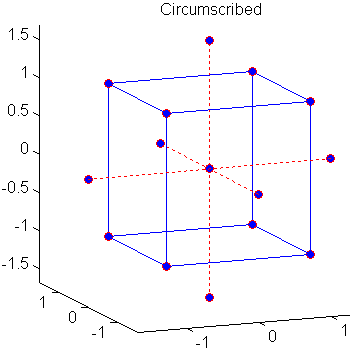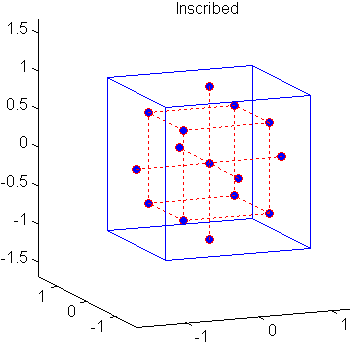Response Surface Designs
Introduction to Response Surface Designs
Quadratic response surfaces are simple models that provide a maximum or minimum without making additional assumptions about the form of the response. Quadratic models can be calibrated using full factorial designs with three or more levels for each factor, but these designs generally require more runs than necessary to accurately estimate model parameters. This section discusses designs for calibrating quadratic models that are much more efficient, using three or five levels for each factor, but not using all combinations of levels.
Central Composite Designs
Central composite designs (CCDs), also known as Box-Wilson designs, are appropriate for calibrating full quadratic models. There are three types of CCDs—circumscribed, inscribed, and faced—pictured below:



Each design consists of a factorial design (the corners of a cube) together with center and star points that allow for estimation of second-order effects. For a full quadratic model with n factors, CCDs have enough design points to estimate the (n+2)(n+1)/2 coefficients.
The type of CCD used (the position of the factorial and star points) is determined by the number of factors and by the desired properties of the design. The following table summarizes some important properties. A design is rotatable if the prediction variance depends only on the distance of the design point from the center of the design.
| Design | Rotatable | Factor Levels | Uses Points Outside ±1 | Accuracy of Estimates |
|---|---|---|---|---|
| Circumscribed (CCC) | Yes | 5 | Yes | Good over entire design space |
| Inscribed (CCI) | Yes | 5 | No | Good over central subset of design space |
| Faced (CCF) | No | 3 | No | Fair over entire design space; poor for pure quadratic coefficients |
Generate CCDs with the function ccdesign:
dCC = ccdesign(3,"Type","circumscribed")
dCC =
-1.0000 -1.0000 -1.0000
-1.0000 -1.0000 1.0000
-1.0000 1.0000 -1.0000
-1.0000 1.0000 1.0000
1.0000 -1.0000 -1.0000
1.0000 -1.0000 1.0000
1.0000 1.0000 -1.0000
1.0000 1.0000 1.0000
-1.6818 0 0
1.6818 0 0
0 -1.6818 0
0 1.6818 0
0 0 -1.6818
0 0 1.6818
0 0 0
0 0 0
0 0 0
0 0 0
0 0 0
0 0 0
0 0 0
0 0 0
0 0 0
0 0 0The repeated center point runs allow for a more uniform estimate of the prediction variance over the entire design space.
Box-Behnken Designs
Like the designs described in Central Composite Designs, Box-Behnken designs are used to calibrate full quadratic models. Box-Behnken designs are rotatable and, for a small number of factors (four or less), require fewer runs than CCDs. By avoiding the corners of the design space, they allow experimenters to work around extreme factor combinations. Like an inscribed CCD, however, extremes are then poorly estimated.
The geometry of a Box-Behnken design is pictured in the following figure.

Design points are at the midpoints of edges of the design space and at the center, and do not contain an embedded factorial design.
Generate Box-Behnken designs with the function bbdesign:
dBB = bbdesign(3)
dBB =
-1 -1 0
-1 1 0
1 -1 0
1 1 0
-1 0 -1
-1 0 1
1 0 -1
1 0 1
0 -1 -1
0 -1 1
0 1 -1
0 1 1
0 0 0
0 0 0
0 0 0Again, the repeated center point runs allow for a more uniform estimate of the prediction variance over the entire design space.